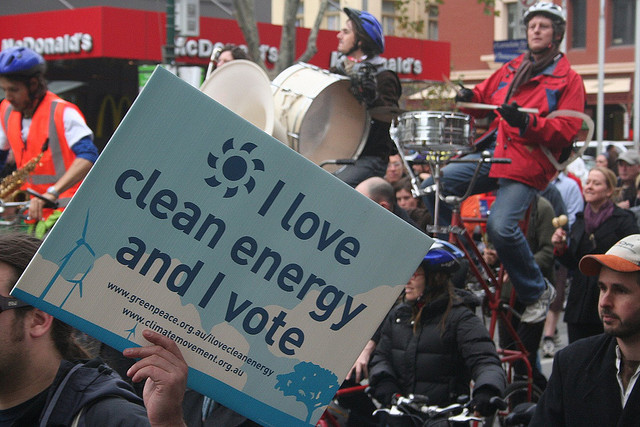
No need to hide in a corner: There are a few signs of hope when it comes to climate change. (Photo by Zen Sutherland.)
Cross-posted from Huffington Post.
With magazines like Scientific American publishing articles titled “Global Warming Close to Becoming Irreversible,” and 15,000-plus temperature records set this spring in the U.S., it’s no wonder the CFO of the business I work for said to me recently, “I have this crippling anxiety about climate change … what are our children going to have to deal with?”
At Keystone, in Colorado, ski season is still going on, but a nearby fire meant the lodge was being used as an evacuation center a few weeks ago. Meanwhile, the Washington Post expressed bafflement about U.S. inaction in the face of obvious climate threats highlighted by the Organization for Economic Cooperation and Development.
This all leaves most of us in the movement to solve climate change with a borderline-debilitating creeping terror that haunts our daily activities, and inclines many of us to want to rock in the corner holding our knees, eating Chinese food out of the box.
But that’s neither productive nor healthy, and Kung Pao stains carpet.
Instead, we need to find signs of hope. And surprisingly, there are a few.
The first very hopeful development comes from science. One of the glaring problems climate realists understand is that it’s going to be very hard to cut CO2 emissions to the levels required globally by 2050 to keep warming to sub-catastrophic levels of about 2 degrees C. It’s just too hard to restructure the global energy infrastructure in that time frame. But Drew Shindell and colleagues at NASA’s Goddard Institute for Space Studies suggest in the journal Science that that may not be necessary. They argue that we can target non-CO2 greenhouse gases — in particular black carbon (soot), methane, and ozone — to cut warming in the short term and buy us time to deal with CO2. Shindell, et al. outline a variety of actions that could prevent 0.5 degrees C of warming by 2050. Better yet, these actions all have major health benefits, preventing “0.7 to 4.7 million annual premature deaths from outdoor air pollution and [increasing] annual crop yields by 30 to 135 million metric tons due to ozone reductions in 2030 and beyond.” This is bipartisan news, because when people are healthy and crops survive, economies do better. You might even want to undertake these measures purely to protect human health and commerce.
The second development is the increasing bipartisan popularity of tax reform that aligns with climate protection. The far right doesn’t like the income tax and loves free markets. And the left wants to solve climate change and hates the fact that externalities aren’t valued by our economics. One way to address both concerns would be to replace part of the payroll tax with a carbon tax. There are several versions of this approach (including James Hansen’s suggestion to dividend the carbon fee back to citizens, which has been endorsed by Republicans for Environmental Protection — or ConservAmerica, as the group is now known), but all of them would be revenue neutral, in that a citizen’s wallet won’t change thickness; they will create market incentives to become more efficient for business and individuals; they will allow businesses to reduce their taxes through efficiency; they will create a free market for the first time by finally accounting for the costs of pollution; and the tax would help solve climate change. A carbon tax is, in a way, more libertarian than leftist; it’s a very conservative idea.
The third sign of hope comes from what I’ll call “stealth policy.” Even though the U.S. government hasn’t been able to pass climate legislation, it has the tools for de facto policy through the Environmental Protection Agency’s (EPA) ability to regulate CO2 as a pollutant, and other mechanisms. Along these lines, President Obama has, with industry cooperation, set strict standards for vehicle efficiency that mean cars in America will get 55 miles per gallon by 2025, a huge increase. Last month, the EPA issued limits on carbon pollution from new power plants, and the agency is legally obligated — by the Clean Air Act and Massachusetts vs. Environmental Protection Agency — to regulate existing power-plant carbon dioxide emissions too. Electricity generation is the No. 1 source of greenhouse gas emissions, so this is big news. Without any new legislation, the U.S. can — and slowly is — reigning in major sources of carbon pollution.
The last sign of hope is really an omen. After a winter that didn’t appear in much of the U.S., this hot March broke some 7,000 heat records.
Climate hawks — activists like Al Gore or Bill McKibben — have always been baffled that Hurricane Katrina, the Pakistan floods, and the recurrent Midwest floods haven’t woken people up to global warming, despite science connecting the flooding to warming and expectations that we’ll see more of the same.
But maybe it’s too hard to connect flooding, or storms, to the planet getting hotter. Maybe, to wake us up, what we really need is some heat.




